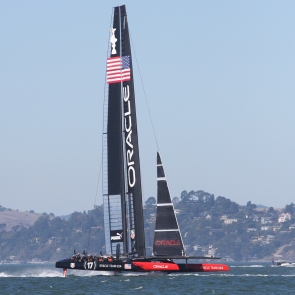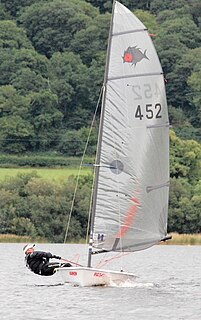
Sailing employs the wind—acting on sails, wingsails or kites—to propel a craft on the surface of the water, on ice (iceboat) or on land over a chosen course, which is often part of a larger plan of navigation.

Yachting is the use of recreational boats and ships called yachts for sporting purposes. Yachts are distinguished from working ships mainly by their leisure purpose.

A yacht is a watercraft used for pleasure or sports. The term originates from the Dutch word jacht, and originally referenced light, fast sailing vessels that the Dutch Republic navy used to pursue pirates and other transgressors around and into the shallow waters of the Low Countries. The yacht was popularized by Charles II of England as a pleasure or recreation vessel following his restoration in 1660.

A sailboat or sailing boat is a boat propelled partly or entirely by sails and is smaller than a sailing ship. Distinctions in what constitutes a sailing boat and ship vary by region and maritime culture.

A sail plan is a set of drawings, usually prepared by a naval architect which shows the various combinations of sail proposed for a sailing ship. Alternatively, as a term of art, it refers to the way such vessels are rigged as discussed below.

The Nordic Folkboat is a small sailboat, rigged as a sloop. The design of this boat was the result of a competition held by the Scandinavian Yacht Racing Union in 1942, who were hoping to create an easily sailed and low-cost boat. The competition produced no outright "winner " but, taking the best features of a number of the entries received, the organisers commissioned professional designer Tord Sundén to create a craft that met the goals of the design competition. The resulting boat went on to become an international favorite of sailors and still endures more than 70 years after its design. The first Nordic Folkboat was built in Gothenburg in Sweden, and as of 2007, more than 4000 Nordic Folkboats are still sailing around the world.

A Bermuda rig, Bermudian rig, or Marconi rig is a configuration of mast and rigging for a type of sailboat and is the typical configuration for most modern sailboats. This configuration was developed in Bermuda in the 17th century; the term Marconi, a reference to the inventor of the radio, Guglielmo Marconi, became associated with this configuration in the early 20th century because the wires that stabilize the mast of a Bermuda rig reminded observers of the wires on early radio masts.

The Laser 4.7 is a one-design dinghy class in the Laser series and is a one-design class of sailboat. All Lasers are built to the same specifications. The Laser is 4.06 m long, with a waterline length of 3.81 m. The hull weight is 59 kg (130 lb). The boat is manufactured by ILCA and World Sailing approved builders.

The Sunfish is a personal size, beach launched sailing dinghy. It features a very flat, board like hull carrying a lateen sail mounted to an un-stayed mast.
The Comet dinghy is a 16-foot-long (4.9 m), two-person, one-design class, racing sloop.

The Bermuda Fitted Dinghy is a type of racing-dedicated sail boat used for competitions between the yacht clubs of Bermuda. Although the class has only existed for about 130 years, the boats are a continuance of a tradition of boat and ship design in Bermuda that stretches back to the earliest decades of the 17th century.

The Pearson Ensign is an American sailboat that was designed by Carl Alberg as a one-design racer and day sailer and first built in 1962. It is the largest full-keel one-design keelboat class in the United States.

The RS Tera is a one-man monohull dinghy in the RS Sailing range of sailing boats. It is recognised by the International Sailing Federation (ISAF) as an international class, and is a popular boat for beginners and for children to race.

The Solution is a single handed hiking dinghy designed for helms in the 65 to 85 kg weight range. It has a light epoxy hull, self draining cockpit, high aspect rig, semi battened 8.5 sq. metre sail, and full complement of dual controls.
The following outline is provided as an overview of and topical guide to sailing:

The Topaz Vibe is a British sailing dinghy designed by Ian Howlett and Rob White. Built by Topper International, it was first introduced in 2006. There are two models, the Vibe and the Vibe X, with the latter carrying larger sails. The Vibe is a World Sailing Learn to Sail class.
The C&C 44 and the C&C 44 Custom are a series of Canadian sailboats, that were designed by Robert W. Ball and first built in 1985.
The Marlow-Hunter 47 is an American sailboat that was designed by the Hunter Design Team as a cruiser and first built in 2016.
The Gougeon 32 is an American trailerable catamaran that was designed by Jan Gougeon and first built in 1990.

The Topper Topaz is a British single-handed or two-handed sailing dinghy that was designed as a beginner and intermediate racer.















